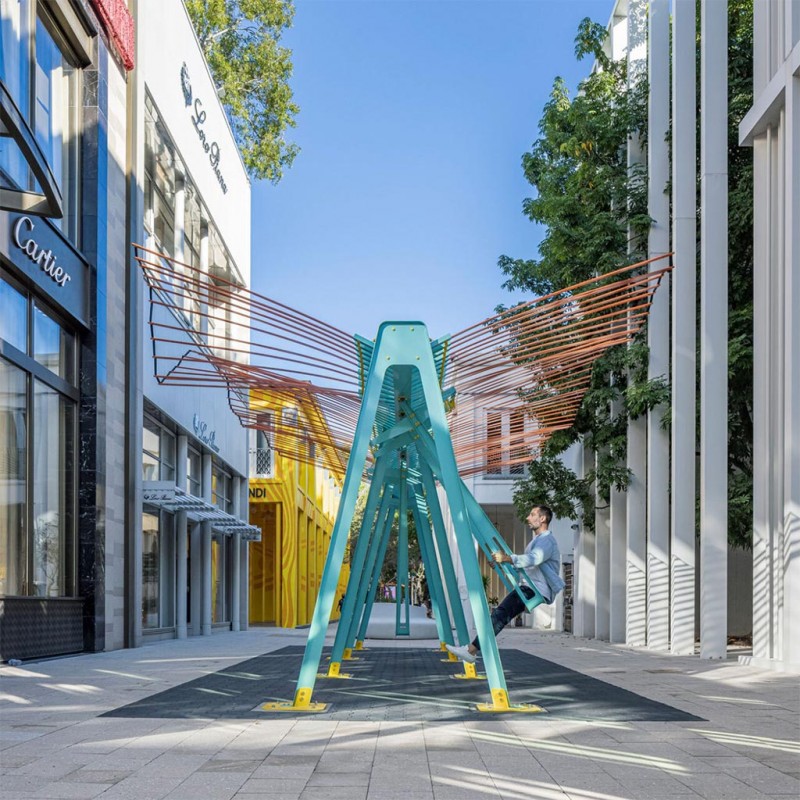

Miami Design District’s Ever-Expanding Collection of Public Art Adds a New Piece Just in Time for Art Week
Nate StoreyTo mark the arrival of Chilean design studio gt2P's Conscious Actions, a series of playground-like architectural structures, we survey the district's most noteworthy public art installations, plus preview the 2020 edition of Design Miami.
In August, a pixelated billboard scrawled with the message “claimed for living, for love and trouble” appeared on the side of the Miami Design District’s Moore Building. Created by the Haitian-Miami artist Adler Guerrier, the work alludes to racial inequality and pays tribute to the Black Lives Matter movement. The commission arose from a partnership between the Design District and For Freedoms, the organization dedicated to artistic forms of civic engagement that artists Hank Willis Thomas and Eric Gottesman launched in 2016.
Once a stretch of pineapple farm, the Design District has mirrored Miami’s cultural growth since it first emerged onto the scene in the early 2000s. Thank the real estate developer and entrepreneur Craig Robins, whose singular vision has turned the neighborhood into an art and design mecca. This year, Design Miami will return to the neighborhood’s Moore Building, where the collectible design fair was first inaugurated within the Miami Art Week constellation back in 2005. It’ll feel different than in years past, with social distancing and other safety protocols enforced due to COVID-19, and with a robust offering of digital experiences.
The Miami Design District, meanwhile, has welcomed a new public commission just in time for art week. The Chilean design, architecture, and art studio gt2P unveil Conscious Actions, a series of architectural structures inspired by joyful interactions with playgrounds. By engaging with the collection of devices, visitors observe a multitude of effects, from reactive shadows and transformative surfaces to kinetic motion. As its collection of public artworks grows, we look back at five standouts from the neighborhood’s nearly two decades of existence.
Buckminster Fuller’s Flys Eye Dome
An original Buckminster Fuller design from 1965, this Monohex version of his signature geodesic domes was prototyped but never completed before the visionary architect’s death. Craig Robins acquired the prototype and partnered with the Buckminster Fuller Institute, who enlisted 3D experts DRDesign, Conform Labs, and Goetz Composites to recreate it with modern materials. Since it was first unveiled, in 2014, Fuller’s “autonomous dwelling machine” is considered an important model for green living—and has become an indelible symbol of the Design District.
Zaha Hadid’s Elastika
The late Pritzker Prize–winning architect’s site-specific sculpture plays a meaningful role in the Design District narrative and remains a powerful symbol of connectivity, both physically and spiritually. In 2005, Hadid’s asymmetrical interventions debuted inside the Moore Building in conjunction with the inaugural Design Miami, where she became the first recipient of the fair’s Visionary Award. The work, comprising two fluid Silly Putty–esque stretches joining four mezzanine levels in the central atrium, is lauded for its innovative spatial thinking and reimagining of the edifice’s Cartesian layout. It remains in situ as an ode to Hadid’s radical design approach and her place in the neighborhood’s history.
Ronan & Erwan Bouroullec’s Nuage
Like a stained glass window inside of a cathedral, Ronan and Erwan Bouroullec’s organic pergola is a facilitator of vibrant shadowplay, reflecting blue and green hues around the Paseo Ponti pedestrian thoroughfare. The French design duo’s interactive piece replicates cloud apertures, providing an ever-changing environment responsive to weather, time, and the evolution of the greenery integrated with the stainless steel structure. Nuage offers a moment of pause for visitors to escape the relenting South Florida sun—or torrential tropical rains—and a meditative respite dotted with intimate ponds and native flora.
Virgil Abloh’s Dollar A Gallon III
Drawing on one of the central themes of Abloh’s work as an artist and designer, his sculpture mimicking gas station signage riffs on advertising and commerce. The sinking terra-cotta Sunoco sign by the Louis Vuitton menswear artistic director and Off-White founder, whose new Miami flagship designed by OMA opened in the district this past spring, is a poignant commentary on the effect of pricing and branding on impressionable minds.
Dozie Kanu’s Support System
Like gt2P’s Conscious Actions, Dozie Kanu’s installation introduces playscape elements to the neighborhood, though their message is more consequential. The colorful monkey bars, climbing frames, and geodomes recall the souped-up cars common to Houston, the furniture designer’s hometown, and provides playful moments for children. But look closer, and the seemingly innocuous installations are engraved with the serial numbers of decommissioned guns recovered from crime scenes. The clandestine clues twinned with intention of playground equipment evoke the human impulse of curiosity and pay homage to victims of gun violence.
ORIGINAL SOURCE